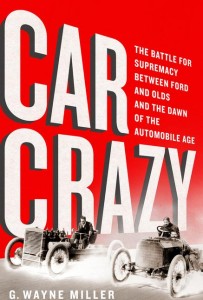
Crazy for Miller’s Attention to Detail in Car Crazy
To read G. Wayne Miller’s Car Crazy is like taking a step back into history. Forget the ages of American muscle cars and large chrome bumpers. Imagine, if you will, a world without autonomous technology, GPS, and convertible tops. Car Crazy harkens back to an era when brass was king, and steam was still considered a viable power option, a none-so-sexy, all-too-dangerous age, to which any car enthusiast must tip their hat, an age which Miller has brought to life more than a century following the car’s humble beginnings, in horse stables and basements the world around.
The Early Years
 The early years of the automotive world were fraught with every imaginable challenge. Cars were dangerous, killing drivers and pedestrians by the score. Motorists required no test before taking to the road. Regulation was non-existent, and naysayers fought tooth and nail to keep the car from ever becoming a mainstream commodity. But become a commodity it did, and eventually, a staple of everyday life, for which car enthusiasts and non-enthusiasts must thank the Ransom E. Olds, Henry Fords, and Fred Smiths, the racers, creative minds, and underhanded businessmen, who took loud, dirty, dangerous machines and changed the world.
The early years of the automotive world were fraught with every imaginable challenge. Cars were dangerous, killing drivers and pedestrians by the score. Motorists required no test before taking to the road. Regulation was non-existent, and naysayers fought tooth and nail to keep the car from ever becoming a mainstream commodity. But become a commodity it did, and eventually, a staple of everyday life, for which car enthusiasts and non-enthusiasts must thank the Ransom E. Olds, Henry Fords, and Fred Smiths, the racers, creative minds, and underhanded businessmen, who took loud, dirty, dangerous machines and changed the world.
Miller, with his unparalleled research, obvious passion, and careful attention to detail, takes an age of the oily, unsuccessful, and oft untold early automobile and gives it the agency it deserves. Following early racers, as they chugged their massive machines through the muck and mud and rivers of the great west, or the early tinkers and engineers, who built the great ancestors of the industry in their barns, Miller gives a wonderful perspective to the before of an industry most known for everything that came after Ford’s Model T success, in 1908.
The depth to which Miller opens up the world of the early auto is staggering, and he sets the stage with elegance – describing everything from the reprehensible driving conditions of cross-country racing to the brilliant wealth of early auto exhibits in the grand hotels of young New York City. Even the duller accounts of history, the all too influential, all too dry Selden patent and subsequent lawsuits, are approached with grace and style, interspersed with tales of cross-country racing, underhanded management by auto company presidents, and bawdy, womanizing racecar drivers.
Information and Commentary
In addition to his simple, yet elegant writing style, which seamlessly threads the integral elements of history through a delightful, but not distracting prose, Miller achieves a wonderful balance of offering information and commentary. His reader finishes the book feeling both academically informed, and prepared for a good-natured debate on how the earliest of America’s auto pioneers directly or indirectly influenced the car industry of today.
It is not an easy feat. Part of Miller’s success stems from a true mastery of a little knowledge, oft-ignored era – the years from 1893 to 1908, when car companies rose and fell by the dozen, when car-based fatalities ran rampant, when automakers like the White Sewing Machine Company of Cleveland placed ads promising that their steam-powered vehicles were “absolutely non-explosive”, and one only knows for good reason. Back then, precious few roads existed outside of the major cities, even fewer of them comprised of manmade materials, and not simply well-padded dirt, which produced a nice mud bath for any passing motorist in the rain.
Miller accounts for each of these details and more, picking carefully the more interesting elements of the age, when speed was measured in single digits, and average cylinders in double. He makes the history of the car into the history of the world, mixing in the politico, the social, the economic, and even the opinion of the horse. More than simply telling of the times, Miller sets the stage for what will become, towards the end of the book, the dawn of modern motoring. He creates a world in which the success of the Model T is simply the next logical choice in a thus far winding and complicated history.
Auto History, Well-Done
To tackle this era, morose with its casually high fatalities, slow, even on the track, and slower still on the roadless race west, would prove challenging to any auto enthusiast. It is not the glamorous era of luxury jazz-age limousines. It is not the sexy and powerful age of modern muscle cars. But it is the fundamental beginning, the paleolithic age to our modern automotive Renaissance, by today’s standard unpolished and archaic, but in the context of its history, a truly incredible time. This dawn of the American Automotive Industry is a must-know era for any auto enthusiast and, with the earliest days of driving in G. Wayne Miller’s capable hands, Car Crazy is a must-read.

